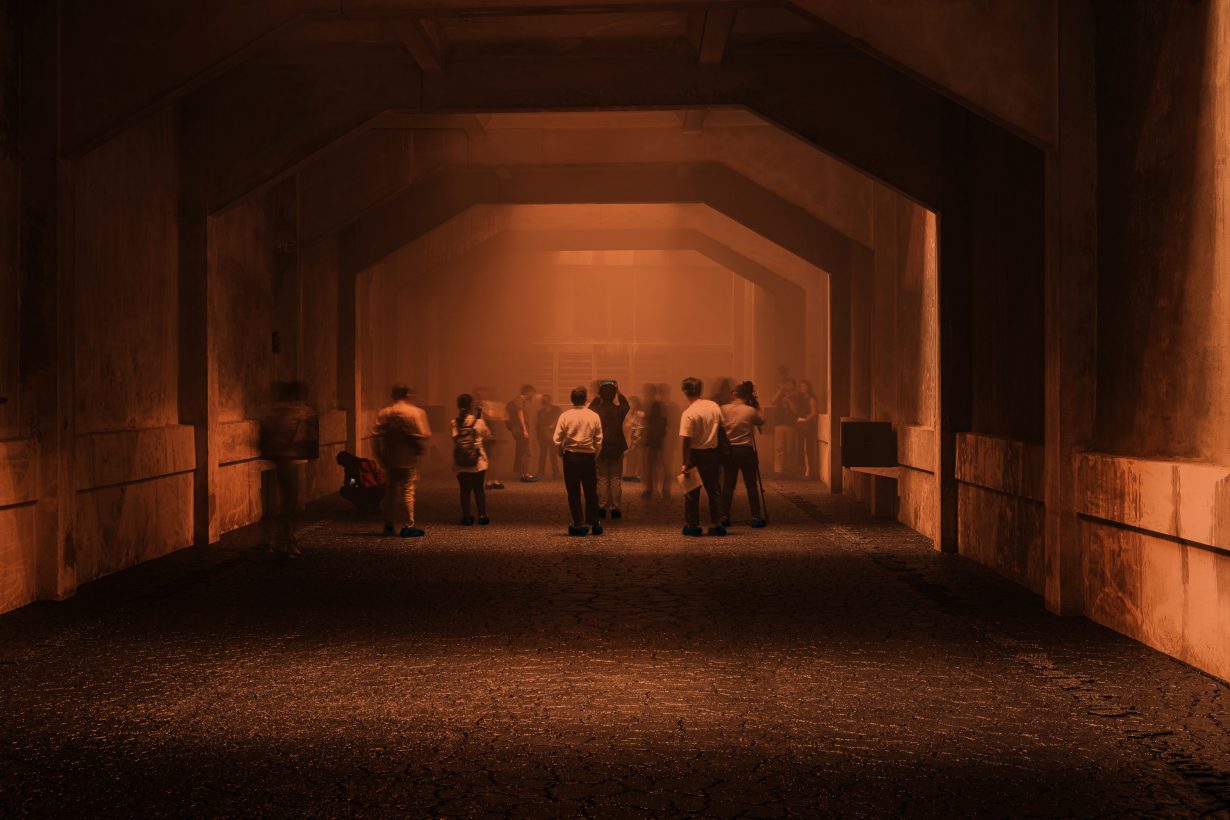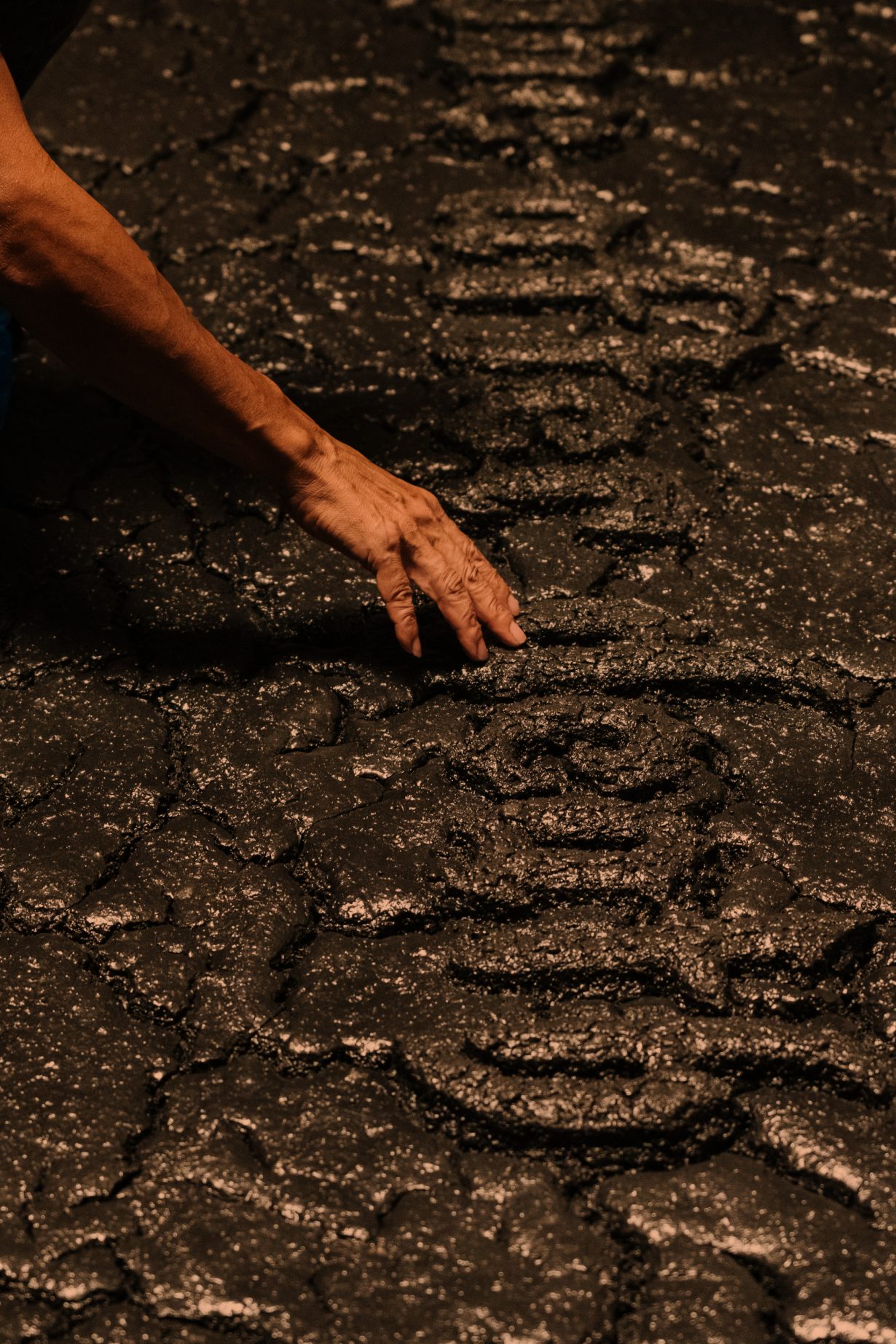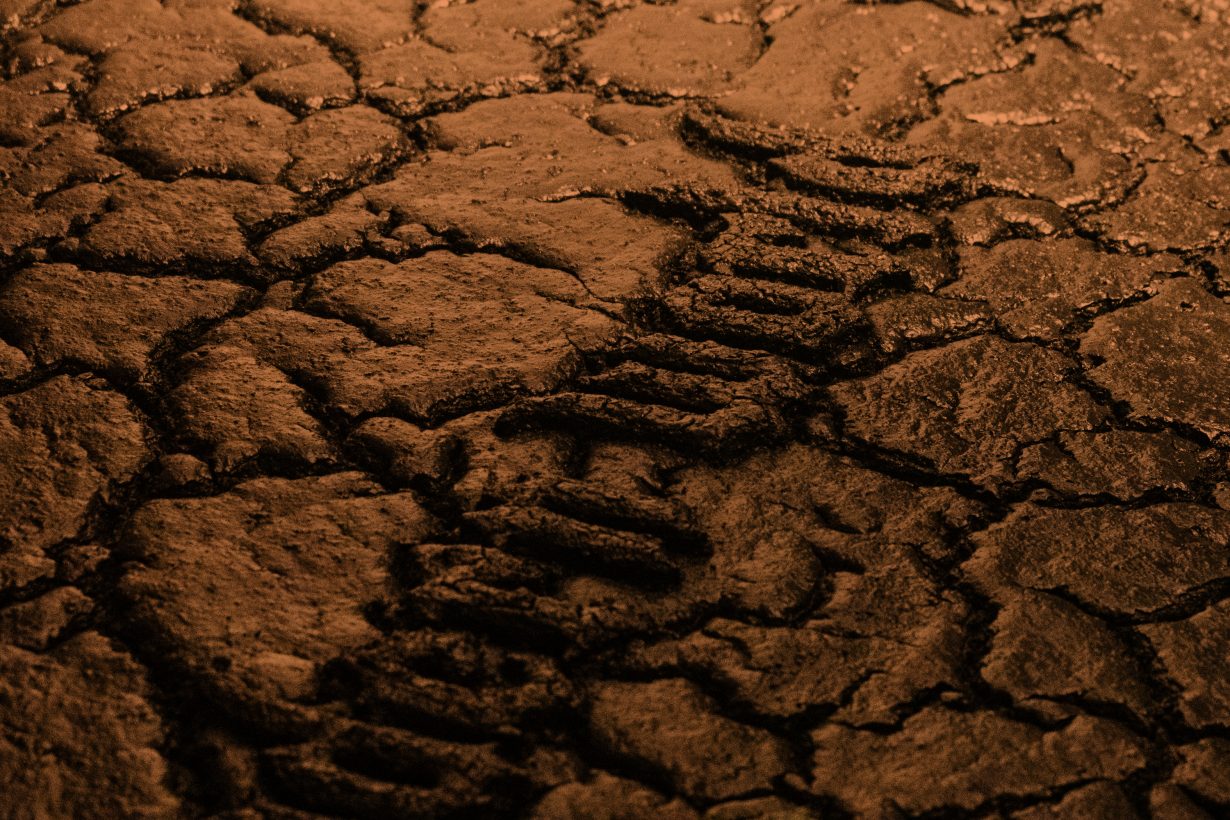At Bangkok Kunsthalle the artist addresses a burning planet, stuck in cycles of renewal and decay. Can art help us find order in it all?
Fire plays an outsized role in Korakrit Arunanondchai’s practice, arguably because it makes palpable the ontological dualities at its core: decline and renewal, death and birth, chaos and order. In his videoworks, flames flicker; on his mixed-media canvases, bleached denim is burnt; in his current exhibition, a blaze appears to have consumed the entire space.
A mixture of compressed ash, earth and paint, the floor of the venue – a hazy, hanger-sized room within Bangkok Kunsthalle (itself located in a Brutalist building in Chinatown that formerly housed a printworks) – is evenly surfaced with what looks like cracked tarmac. It appears that this otherwise empty space has seen scorching, white-hot temperatures. Or, I hazard after further exploration, an occult event. Lines of Gothic text are embossed along the floor’s edge on all four sides. The first words I make out in the jaundiced half-light mangle the words of the Anglican burial service: “From dust to dust, give us rebirth for beings that never materialised.” A fire ritual has been performed here, it would seem, and its incantations or prayers branded in the fissured floor for posterity.

Activating this dank, pyro-spiritual realm is a complex array of wall-mounted speakers and bass bins. While Arunanondchai is chiefly known for video installations nested within busy techno-organic environments full of tactile signifiers and large beanbags, nostalgia for unity is stripped down and sound driven: looping within the dystopic space of Bangkok Kunsthalle’s repurposed architecture is a sonic restaging of this arcane performance. A soundscape that envelops the body jolts and soothes in roughly equal measure, joined only by crepuscular shafts of light, dry ice and the stamp of past rituals.
The net effect of this emptying out is not as pronounced as you might expect. As with the artist’s videoworks, the looping audio track is a collage that veers from elegiac stillness to peaks of ecstasy. In its more serene moments, it offers tingle-inducing sonic flair – a tactic perhaps borrowed from ASMR, or the darker end of the ambience video genre wherein listeners are immersed in post-Blade Runner environments drenched in the lush sounds of failing rain and droning synth pads. And at its most kinetic, layers of angelic wailing build to an orchestral crescendo befitting the hands-aloft breakdown of a euphoric EDM track, but culminate with shouting, not a kick drum. Layers of sound then fall away, leaving reverb tails and a metallic clanging reverberating off the mildewed walls.

Incorporeal beings – characters who possess a similar yen for mystical profundities, and an attunement to animistic or pagan energies, as the white-clad worshippers that dance around bonfires in Arunanondchai’s videos – interject at junctures to recite passages of the prayer. “Blood of the earth… cover us from the downpour… of a sky drenched in flames,” a child pronounces at one point. “The ghosts take us by the hand. Decompose what is left,” declare a low-pitched chorus at another.
These lyrical verses are bombastic. More mind-altering, for me, are the unnerving lulls and fey interludes sandwiched between them, when disembodied voices and ambient noises – a feverish breakout of wheezing, hissing, whistling and shushing, for example – invite us to zig-zag gingerly through the space. Most effective are Arunanondchai’s experimentations with negative space and a sort of auditory-visual synesthesia (a painting that incorporates, or functions alongside, sound).

Augmented by the gloom of the tenebrous setting, as well as the synced floodlights that momentarily light up the space, his carefully orchestrated and layered soundscape – a script for an absent film, essentially – concretises a mannered cycle of renewal and decay, of rising up and falling down, of heat surging and subsiding, amid hostile conditions. According to the exhibition text, the work was inspired by the history of the building, which was partly destroyed by a fire in the early 2000s, and which Arunanondchai sees as ‘a body of a giant, decomposing in time’. But less localised meanings are sparked by the reference books displayed on a table near the entrance.
Among them is philosopher Michael Marder’s The Phoenix Complex (2023), in which he argues that the ideological and, for the most part, unconscious conception of nature as a phoenix that can regerminate is incompatible with today’s global ecological crisis. Marder’s claim that ‘The ashes of our age are not fecund; they are the sterile signs of the death of death’ chimes with Arunanondchai’s sickly, fire-cracked environment (a ‘landscape of mourning’, as the prayer puts it, that evokes a sense of environmental aridity and hypoxia). Humanity’s belief in earth’s infinite capacity for rebirth is erroneous, incompatible with today’s realities, Marder argues. nostalgia for unity can be read as an attempt to act out this rift by juxtaposing blind faith – a hope and a prayer for nature’s continued phoenix-like resurgence – with the empirical evidence of the senses.
nostalgia for unity at Bangkok Kunsthalle, through 31 October
